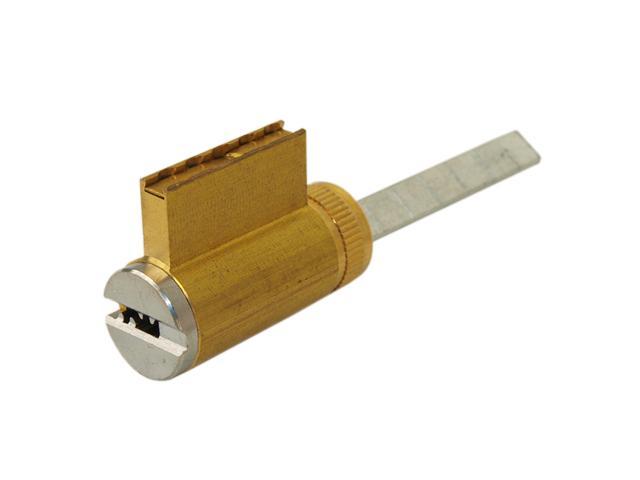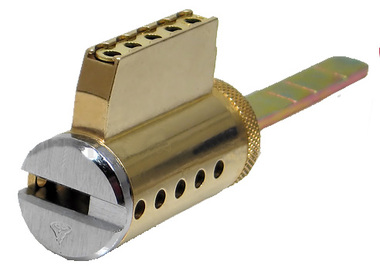The core of a lock is a fascinating topic. It’s the heart of a lock, controlling access and security. Just like a heart pumps blood, the lock’s core directs the key, ensuring only the right one can unlock it. This core, often cylindrical, houses pins, springs, and tumblers. When you insert the correct key, it aligns these components, allowing the lock to open. Understanding the lock’s core can be a fun journey into the world of mechanics and security. So, let’s research what is the core of a lock.

What Is The Core Of A Lock?
A lock core is the core of a lock, a pivotal part that makes a lock work. At the point when you turn the key, the lock core moves, permitting the lock to open or close.
Presently, we should envision you’re an investigator. You’re attempting to settle a secret, and the lock core is your hint. Very much like a criminal investigator, you want the right key to open the secret. In our situation, the key is information. With the right information, we can comprehend how the lock core functions.
Keep in mind, that the lock core resembles a riddle. Each piece needs to fit flawlessly for the lock to work. On the off chance that one piece is missing or doesn’t fit, the lock won’t open. Along these lines, it means quite a bit to realize how each piece fits together.
The Importance and Role of the Lock Core
The lock core, frequently disregarded, assumes a vital part in our regular routines. It’s the core of a lock, the part that makes a lock work. This straightforward yet brilliant component keeps our homes, vehicles, and assets safe.
Presently, how about we research the significance and job of the lock core?
1. Security
The essential job of the lock core is to give security. The piece of the lock cooperates straightforwardly with the key. A very much made lock core can oppose picking, boring, and different types of assault. It’s the main line of protection against unapproved access.
2. Durability
A decent lock core is solid and can endure rehashed use. It’s produced areas of strength for use that can oppose mileage. This guarantees that the lock stays useful after some time, giving steady security.
3. Versatility
Lock cores come in different kinds and sizes, each intended for a particular application. From entryway locks to latches to vehicle locks, each utilizations an alternate sort of lock core. This flexibility permits us to get a large number of things.
4. Key Control
The lock core likewise assumes an urgent part in key control. The piece of the lock figures out which keys can open it. This permits us to control who approaches our homes, vehicles, and assets.
5. Ease of Replacement
Lock cores are intended to be effectively replaceable. If a key is lost or a lock is compromised, you can supplant the lock core without supplanting the whole lock. This makes keeping up with security more helpful and practical.
Anatomy of a Lock Core
A lock core is the core of a lock, the part that connects with the way to get or deliver the lock. We should investigate the life structures of various sorts of lock cores.
A. Cylinder Locks
Chamber locks are normal and adaptable, utilized in everything from ways to latches.
Pin Tumbler System: The pin tumbler component is a locking component utilized in chamber locks where a bunch of pins or tumblers hold the secure. The key has a progression of indents or spaces that compare to the pins. At the point when the right key is embedded, it pushes the pins up to the specific level that permits the chamber to turn and open.
Components of the Core: The core of a chamber lock contains a few parts. The fitting is the part into which the key is embedded. The driver pins and key pins are the sets of pins that keep the attachment from turning when some unacceptable key is embedded. The springs push the pins down into the fitting. The shear line is the meager line between the attachment and the lodging of the lock where the pins should adjust for the lock to open.

B. Other Types of Lock Cores
Wafer Locks: Wafer locks utilize a bunch of level wafers to keep the lock from opening except if the right key is embedded. The key raises the wafers to the right level, permitting the fitting to turn. These locks are much of the time utilized in vehicles and cupboards.
Disc Detainer Locks: Plate captor locks utilize a bunch of pivoting circles. Each plate has a space cut into it, and the key adjusts these spaces, permitting a sidebar to drop into the openings and the lock to open. These locks are in many cases utilized in high-security applications because of their protection from picking.
Lever Locks: Switch locks utilize a bunch of switches to keep the lock from opening. The key lifts the switches to the right level, permitting the locking bolt to move. These locks are in many cases utilized in safes and entryways.
All in all, the lock core is a little however imperative piece of our security foundation. Its job in giving security, sturdiness, adaptability, key control, and simplicity of substitution makes it a crucial piece of our lives. Thus, the following time you turn critical in a lock, spare an idea for the modest lock core.
